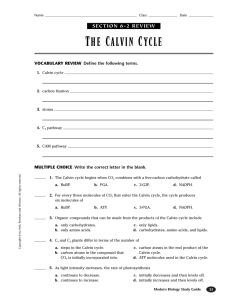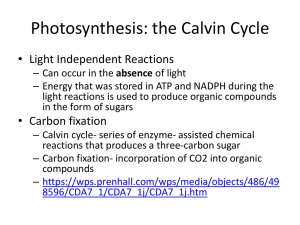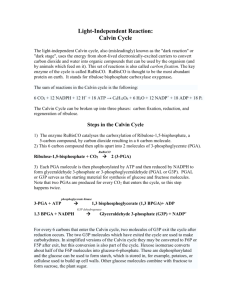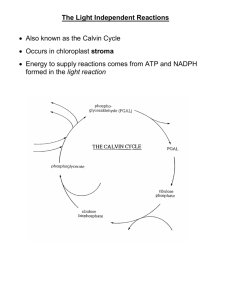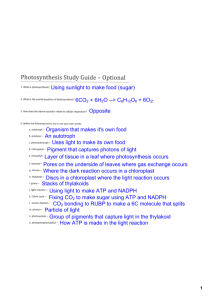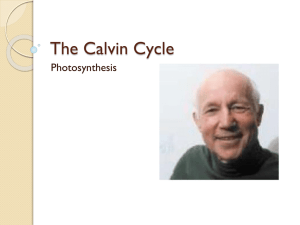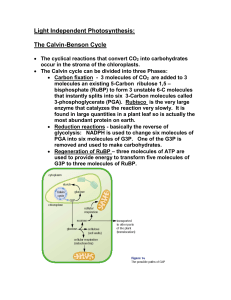The Calvin cycle uses ATP and NADPH to convert CO2 to sugar
advertisement
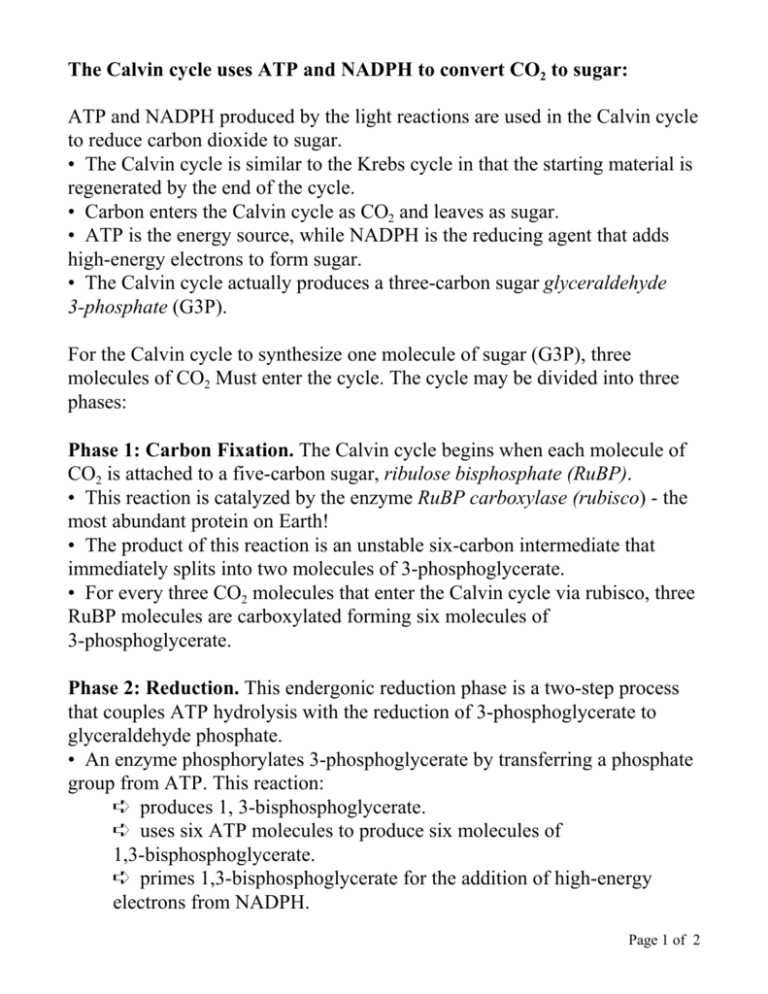
The Calvin cycle uses ATP and NADPH to convert CO2 to sugar: ATP and NADPH produced by the light reactions are used in the Calvin cycle to reduce carbon dioxide to sugar. • The Calvin cycle is similar to the Krebs cycle in that the starting material is regenerated by the end of the cycle. • Carbon enters the Calvin cycle as CO2 and leaves as sugar. • ATP is the energy source, while NADPH is the reducing agent that adds high-energy electrons to form sugar. • The Calvin cycle actually produces a three-carbon sugar glyceraldehyde 3-phosphate (G3P). For the Calvin cycle to synthesize one molecule of sugar (G3P), three molecules of CO2 Must enter the cycle. The cycle may be divided into three phases: Phase 1: Carbon Fixation. The Calvin cycle begins when each molecule of CO2 is attached to a five-carbon sugar, ribulose bisphosphate (RuBP). • This reaction is catalyzed by the enzyme RuBP carboxylase (rubisco) - the most abundant protein on Earth! • The product of this reaction is an unstable six-carbon intermediate that immediately splits into two molecules of 3-phosphoglycerate. • For every three CO2 molecules that enter the Calvin cycle via rubisco, three RuBP molecules are carboxylated forming six molecules of 3-phosphoglycerate. Phase 2: Reduction. This endergonic reduction phase is a two-step process that couples ATP hydrolysis with the reduction of 3-phosphoglycerate to glyceraldehyde phosphate. • An enzyme phosphorylates 3-phosphoglycerate by transferring a phosphate group from ATP. This reaction: - produces 1, 3-bisphosphoglycerate. - uses six ATP molecules to produce six molecules of 1,3-bisphosphoglycerate. - primes 1,3-bisphosphoglycerate for the addition of high-energy electrons from NADPH. Page 1 of 2 • Electrons from NADPH reduce the carboxyl group of 1,3-bisphosphoglycerate to the aldehyde group of glyceraldehyde 3-phosphate (G3P). - The product, G3P, stores more potential energy than the initial reactant, 3-phosphoglycerate. - G3P is the same three-carbon sugar produced when glycolysis splits glucose. • For every three CO2 molecules that enter the Calvin cycle, six G3P molecules are produced, only one of which can be counted as net gain. - The cycle begins with three five-carbon RuBP molecules – a total of 15 carbons. - The six G3P molecules produced contain 18 carbons, a net gain of three carbons from CO2. - One G3P molecule exits the cycle; the other five are recycled to regenerate three molecules of RuBP. Phase 3: Regeneration of Starting Material (RuBP). A complex series of reactions rearranges the carbon skeletons of five G3P molecules into three RuBP molecules. • These reactions require three ATP molecules. • RuBP is thus regenerated to begin the cycle again. For the net synthesis of one G3P molecule, the Calvin cycle uses the products of the light reactions: - 9 ATP molecules - 6 NADPH molecules G3P produced by the Calvin cycle is the raw material used to synthesize glucose and other carbohydrates. • The Calvin cycle uses 18 ATP and 12 NADPH molecules to produce one glucose molecule. Page 2 of 2
